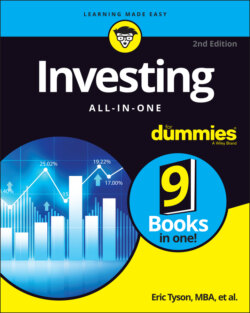Читать книгу Investing All-in-One For Dummies - Eric Tyson - Страница 31
Purchasing-power risk (also known as inflation risk)
ОглавлениеIncreases in the cost of living (that is, inflation) can erode the value of your retirement resources and what you can buy with that money — also known as its purchasing power. When Teri retired at the age of 60, she was pleased with her retirement income. She was receiving a $1,600-per-month pension and $2,400 per month from the money that she had invested in long-term bonds. Her monthly expenditures amounted to about $3,000, so she was able to save a little money for an occasional trip.
Fast-forward 15 years. Teri still receives $1,600 per month from her pension, but now she gets only $1,800 per month of investment income, which comes from some certificates of deposit. Teri bailed out of bonds after she lost sleep over the sometimes roller-coaster-like price movements in the bond market. Her monthly expenditures now amount to approximately $4,000, and she uses some of her investment principal (original investment). She’s terrified of outliving her money.
Teri has reason to worry. She has 100 percent of her money invested without protection against increases in the cost of living. (Her Social Security does have inflation adjustments.) Although her income felt comfortable at the beginning of her retirement, it doesn’t work at age 75, and Teri may easily live another 15 or more years.
The erosion of the purchasing power of your investment dollar can, over longer time periods, be as bad as or worse than the effect of a major market crash. Table 2-2 shows the effective loss in purchasing power of your money at various rates of inflation and over differing time periods.
Skittish investors often try to keep their money in bonds and money market accounts, thinking they are “playing it safe.” The risk in this strategy is that your money won’t grow enough over the years for you to accomplish your financial goals. In other words, the lower the return you earn, the more you need to save to reach a particular financial goal.
TABLE 2-2 Inflation’s Corrosive Effect on Your Money’s Purchasing Power
| Inflation Rate | 10 Years | 15 Years | 25 Years | 40 Years |
|---|---|---|---|---|
| 2% | –18% | –26% | –39% | –55% |
| 4% | –32% | –44% | –62% | –81% |
| 6% | –44% | –58% | –77% | –90% |
| 8% | –54% | –68% | –85% | –95% |
| 10% | –61% | –76% | –91% | –98% |
A 30-year-old wanting to accumulate $500,000 by age 65 would need to save $440 per month if she earns a 5 percent average annual return, but she needs to save only $170 per month if she earns a 9 percent average return per year. Younger investors need to pay the most attention to the risk of generating low returns, but so should younger senior citizens. At the age of 65, seniors need to recognize that a portion of their assets may not be used for a decade or more from the present.
